

Oogenesis begins with mitotic division of a small number of oogonia along the gonadal mesoglea, a thin layer composed of extracellular matrix. Sites of germ cell development are often observed as swellings in polyps during active gametogenesis, and are termed gonads. Generally, scleractinian germ cells are developed in endodermal mesenteries of polyps. Gametogenesis is a highly organized process whereby genetically diverse haploid gametes are created from diploid germ cells through meiosis with recombination. Although large amounts of data are now available from more than four hundred species, our current understanding of intrinsic mechanisms underlying key processes of sexual reproduction, such as sex determination/differentiation, gametogenesis, and ovulation/spawning, is quite limited. Studies on various aspects of sexual reproduction, such as the timing of broadcast spawning or brooding, general cellular processes of gametogenesis, and sexuality (hermaphroditic or gonochoric), have been undertaken mainly from an ecological perspective in many scleractinian species in many locations during the past 3 decades. Since the discovery of scleractinian mass spawning events in the Great Barrier Reef in the 1980s, sexual reproduction of scleractinians has captured the attention of researchers and the general public. Furthermore, our transcriptome assembly will be a useful reference for future development of sex-specific and/or stage-specific germ cell markers that can be used in coral aquaculture and ecological studies. This study and associated datasets provide a foundation for future studies regarding gametogenesis and differences between male and female colonies from molecular and cellular perspectives. To the best of our knowledge, this study is the first to create a gonadal transcriptome assembly from any scleractinian. Our findings show that scleractinian gametogenesis shares many molecular characteristics with that of other metazoans, but it also possesses unique characteristics developed during cnidarian and/or scleractinian evolution. Meanwhile, a large number of genes without homology to sequences in the SWISS-PROT database were also observed among upregulated genes in premature / mature ovaries and mature testes. Upregulated genes included those involved in gametogenesis, gamete maturation, sperm motility / capacitation, and fertilization in other metazoans, including humans. In premature/mature ovaries, 631 genes were specifically upregulated, with 538 in mature testes. Analysis of 4 developmental phases identified 2023 genes that were differentially expressed during oogenesis and 678 during spermatogenesis.

ancora gonadal transcriptome of 35,802 contigs. De novo assembly of trimmed reads, and elimination of contigs derived from symbiotic dinoflagellates (Symbiodiniaceae) and other organisms yielded a reference E. Resultsġ.6 billion raw reads were obtained from 24 gonadal samples. In particular, we explored genes associated with oocyte development and maturation, spermiogenesis, sperm motility / capacitation, and fertilization. In this study, to better understand mechanisms underlying gametogenesis, we isolated ovaries and testes at different developmental phases from a gonochoric coral, Euphyllia ancora, and adopted a transcriptomic approach to reveal sex- and phase-specific gene expression profiles. Although extensive ecological data has been acquired, underlying molecular and cellular mechanisms remain largely unknown. Sexual reproduction of scleractinians has captured the attention of researchers and the general public for decades.


 0 kommentar(er)
0 kommentar(er)
